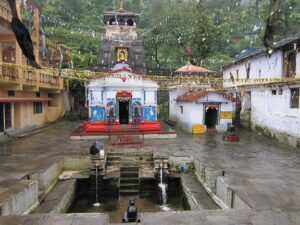
Guptakashi is a fairly large town located at an elevation of 1,319 metres (4,327 ft) in Garhwal Himalayas of Rudraprayag district, Uttarakhand. The name Gupt Kashi means “Hidden Benares,” and the town’s sacred identity plays on its identity with the more famous pilgrimage site.
The temple town is located on the way to the Kedarnath, one of the Chota Char Dhams and Panch Kedars. It has the scenic backdrop of the snow-covered peaks of Chaukhamba and enjoys a salubrious weather throughout the year.
Its religious importance is considered next to that of Varanasi, believed to be the most pious of all Hindu pilgrimage places.
Legend and Mythology
Mythology states that Lord Shiva proposed to goddess Parvati at Guptakashi before they got married in the small Triyuginarayan village at the confluence of River Mandakini and Son Ganga.
Popularly-narrated legend holds that subsequent to the Kurukshetra war of the epic Mahabharata, the Pandavas on the advice of Lord Krishna and other sages wished to atone for their sins of fratricide and Brāhmanahatya committed by them during the war by seeking pardon from Shiva and also pray for his blessings before attaining salvation. But Shiva was not willing to meet them since he was annoyed with them for the unjust events of the war. He, therefore, avoided meeting them at Kashi and went incognito as the bull Nandi to Guptakashi in Uttarakhand. But Pandavas pursued him to Guptakashi and recognized him in the disguised form of Nandi. When Bhima, the second Pandava brother tried to hold the bull by its tail and hind legs, Nandi vanished from Guptakashi, into the ground (into a cave for hiding), but reappeared later as Shiva in five different forms namely, hump at Kedarnath, face at Rudranath, arms at Tungnath, navel and stomach at Madhyamaheshwar and the locks at Kalpeshwar. The vanishing act of Shiva gave the name Guptakashi (hidden Kashi) to this place on the bank of the Mandakini River.
According to Puranic literature, Kashi and Kanchipuram are considered as two eyes of Shiva. Keeping this connotation in view, six more Kashis have been prescribed to be as sacred and spiritual as the main Kashi – Varanasi. Pilgrims, who cannot undertake the long journey to the main Kashi, can travel to the closest Kashi. The six other “Kashi”s cover all the regions of the country. These are: Uttarkashi and Guptakashi in Uttarakhand in Northern Himalayas.
Another legend declares that when the Mughal emperor Aurangzeb demolished the Kashi Vishwanath Temple in 1669, and constructed Gaynvapi Mosque, the Shiva Linga was shifted to Guptakashi for safe keeping. But the original linga of Kashi Vishwanath is stated to have remained here from the time it was shifted.
Vishwanath temple
Guptkashi’s main temple is to Lord Shiva as Vishwanath, “Lord of the Universe”. The Temple is built by the regional stones and has an enclosed courtyard. As per the architecture style and beauty of the temple is considered, it is similar in style and design as the other important temples of Kedarnath and Guptkashi. At the entrance of Vishwanath Temple Guptkashi, there are two guards and at the top of the gate, there is an image of Bhairava, which is another form of Lord Shiva who is here to guard the entire place. Around this temple, visitors will have an opportunity to view various lingas which justifies the popular terminology of this place ‘Jitne pathar utne shankar’ and truly justify the Hindu mythology that Shiva is available everywhere in various forms. As per the legends Vishwanath temple is the place where Lord Shiva proposed to Goddess Parvati for marriage.
Ardhanarishwar Temple
On the left of Vishwanath temple we have the temple dedicated to Ardhanarishwar. The temple idol is a synthesis of half man and half woman. The idol depicts the union of Lord Shiva and Goddess Parvati. The idol depicts the fact that the female principle of God is inseparable from the male. Legend speaks of Lord Mahadev enlightening Sage Bhringi with the concept of Shiva-Shakti and when he saw that Sage was unable to grasp the significance Goddess Parvati took away all elements of nature from his body resulting in which only ashes was left. This lesson cleared away the confusion from Sage Bhringi’s mind and he understood that Shiv-Shakti is one, one cannot exist without the other and their equilibrium is essential for the existence of creation. The form of Ardhnarishwar (half man-half woman) was displayed by Lord Shiva and Goddess Parvati at that moment to all the celestial sages present.
At the entrance to this temple there is metallic statue of Nandi facing Shiva’s image in the temple and offering reverential worship. This statue has a Swastika, a typical Hindu symbol, painted on its side, with its arms aligned in a clockwise direction, considered as an auspicious direction.
Manikarnika Kund
It is a small pond (kund) in front of the Vishwanath temple; a Shiva-linga is bathed by two springs, representing the rivers Ganges (Bhagirathi) and Yamuna. The Yamuna spring water emanates from a goumukh (spout in the shape of a cow’s mouth) and the Bhagirathi spring flows through trunks of two elephants strategically placed above the linga.
Source:
http://www.sightseeings.co/uttarakhand/guptakashi/vishwanath-temple
https://www.euttaranchal.com/tourism/guptkashi.php
https://www.sacredyatra.com/guptakashi
https://personal.carthage.edu/jlochtefeld/picturepages/pilgguptkashi.html
http://www.eziitours.in/travelogue/guptakashi-temple-town-garhwal-himalayas/
https://traveldreams.live/2017/10/29/in-case-you-decide-to-visit-hidden-benaras-guptkashi/
https://en.wikipedia.org/wiki/Guptakashi


